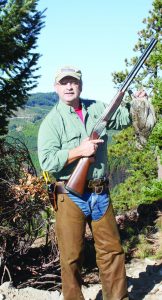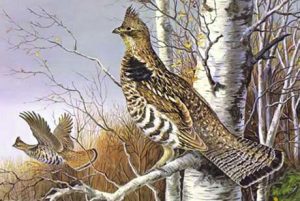by Dave Workman | Senior Editor

Author Workman with a pair of fat blue grouse, taken high in Washington State’s Central Cascades.
My first live game was kind of a scrawny grouse, but at the time I was a scrawny kid maybe 11 or 12 years old, so it was something of an even match.
The fool hen evaporated in a cloud of feathers created by a load of No. 6 high base Winchester lead pellets decades ago along an old logging “skid road” that wasn’t really a road at all on the southeast side of Huffaker Mountain not far from Randle, WA. The gun was an old 16-gauge single-shot Harrington and Richardson with an exposed hammer, and the barrel was a little sloppy and had no bead. My dad admonished me to be a little more careful the next time, between fits of laughter.
I hunted with that gun for most of my teen years, until a first decent college-age job put enough money in my pocket to afford a used Beretta 12-gauge side-by-side with fixed chokes, 28-inch barrels, straight grip and raised comb. I still have that gun today and would not part with it for a fortune. Some things you just don’t let go of, like an affinity for grouse hunting.
Some years ago, I started hunting with a 20-gauge double. The grouse keep showing up, as though they believe they’ve finally got my number.
If the gods will it, I’ll be out of the office on Sept. 1, the traditional grouse opener in Washington state. Grouse, in my book, are perhaps the most and sometimes least challenging of all gamebirds, with ruffed grouse offering some excellent shooting and the larger blue grouse offering some excellent table fare.
Many folks prefer No. 7½ shot for thunder chickens, but I’m a firm believer in the No. 6. It has always patterned well in any shotgun I’ve owned, and it can reach out a ways and tear through leafy brush far better than a lighter pellet. Besides, when one comes up against a couple of chicken-sized blue grouse, one is better off with a heavier pellet.
Ruffed grouse like stands of mixed hardwood and softwood all over the northern tier states. I’ve found them in alder and vine maple thickets, around old orchards, and in forests of fir and hemlock. They can be remarkably fast, and they launch from hiding with a nerve-rattling eruption.

Ruffed grouse like the ones depicted on this early Ruffed Grouse Society stamp are resident of old hardwoods and elusive and exciting targets for small game hunters.
According to the Ruffed Grouse Society, this non-migratory gamebird can be found in most states, and they have a varied diet that includes leaf vegetation, some berries, insects and even other living creatures. Later in the season, with snow on the ground, they eat “dormant flower buds or catkins of trees such as the aspens, birches, cherries, ironwood and filberts,” according to Society literature.
Blue grouse can be found at higher elevations in the West, where conifers dominate. I’ve found them around wild huckleberry fields, along old gravel logging roads morning and evening, alders and other hardwoods, and even a few times in the middle of high meadows where there might be a few nearby trees. They eat insects, berries and seeds, but in the winter they are needle eaters.
They come out to the roads to pick up pea gravel to help grind up food in their gizzards. It makes them sitting ducks (pun intended) and once they are off the roadway, they’re fair game. One never shoots a grouse in, across or from the road.
Blue grouse are often called “fool hens” because they will just sit out in the wide open staring at you as though nothing was happening. I’ve called them a few other things not fit for print when they literally explode in a flurry of thundering wings at the least opportune moment. In Alaska, they’re called “hooters” and some people even call them by blowing across the top of an empty long-necked glass bottle.
Ah, but they are good eating. Breast out a blue grouse or a large ruffed grouse and prepare it using any number of different recipes, and it is table fare that is hard to beat.
I prefer hunting grouse with a double gun, nowadays fitted with improved cylinder and modified choke tubes. One never knows when a follow-up shot will be necessary and the modified choke will keep the pattern tighter at a longer range. Up close, you want that shot to spread out faster.
Back east and in the Great Lakes region, people often hunt grouse with fine dogs. It is a gentleman’s sport, and they are pretty good at it.
Out west, I’ve been known to head-shoot blue grouse with a .22 rifle or pistol. Sure that’s almost blasphemy to the purist, but in my camp, purity takes a distant second place to eating grouse for dinner.
It is important for anyone hunting with a pal early in the season to wear fluorescent orange. Working those thick hardwoods with all the leaves still on can make for some interesting times if your partner loses track of where you are.
Be sure to read the regulations carefully, and be willing to work for your birds. Some people will clean them thoroughly and pluck them to roast whole. I prefer to breast them out and take the legs. Cook them slowly until golden brown and dig in. A bit of seasoning salt, or whatever your taste buds allow, and you will be hooked.



